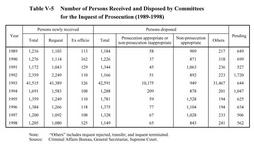| Previous Next Index Image Index Year Selection | |
|
|
2 Relief measures against non-prosecution Japan adopts the principle of prosecution by the state. This means that the right of public prosecution is only accorded to public prosecutors, with the exception of the so-called quasi-prosecution procedure concerning requests for the commencement of a hearing. Public prosecutors are also given broad discretionary power on whether to institute public prosecution. However, misjudgment by a public prosecutor may result in non-prosecution of a suspect who should be prosecuted. For this reason, legal procedures for the relief of complainants, victims, and others have been established against the disposition of non-prosecution by public prosecutors. These procedures include the right to request a review by the Committees for the Inquest of Prosecution and the right to request commencement of a hearing by the district court in charge.
The system of requests for reviews by the Committees for the Inquest of Prosecution was established by the Law for the Inquest of Prosecution(Law No.147of1948). In light of the spirit of the Constitution, this Law was enacted and promulgated along with the Code of Criminal Procedure in July1948(effective from the same month). The aim was to ensure fairness in exercising the right of public prosecution by reflecting the will of the people as much as possible. The system of requests for commencement of hearings, stipulated in the Code of Criminal Procedure, is available to complainants or accusers of various types of abuse of authority committed by public officials. In practice, dissatisfaction with the disposition of non-prosecution by public prosecutors may be expressed to the chief of a higher public prosecutors office in order to request exercise of the power of supervision, although no legal provisions exist for such a procedure. Upon receiving such a request, the higher public prosecutors office reviews the disposition and notifies the result to the dissatisfied party. (1)Committee for the Inquest of Prosecution 201Committees for the Inquest of Prosecution have been established nationwide, each with11members chosen by lot from the electoral roll for a term of six months each. By request or ex officio, the Committees review the disposition of non-prosecution made by public prosecutors to determine if prosecution should be instituted, or whether the non-prosecution is appropriate or not. Those qualified to make such a request used to be limited to complainants, accusers, claimants and victims. However, the Law for Partial Amendment to the Code of Criminal Procedure and the Law for the Inquest of Prosecution provide that the spouse, blood relatives and siblings of a victim are eligible to make such a request if the victim is dead. The amendment also stipulates that applicants for review may submit written opinions or related documents to the Committees. The amendment took effect in June2000. Although the decision of the Committees is not legally binding, chief prosecutors must act on any decision that prosecution should be instituted or that non-prosecution is inappropriate by initiating public prosecution, provided that they are convinced of the appropriateness of such action. Table V-5 shows the number of persons received and disposed by the Committees in the10-year period from1989. The numbers of persons newly received and disposed was substantially high in1994,as they included Diet members(40,305persons)who were accused by a large number of citizens for Political Funds Control Law(quantitative regulation)violations concerning donations made to them. Table V-5 Number of Persons Received and Disposed by Committees for the Inquest of Prosecution(1989-1998) 1,111persons were newly received in1998for penal code offenses. These included420for professional negligence resulting in death or bodily injury,141for forgery,105for bodily injury(including bodily injury resulting in death),63for fraud and55for abuse of authority(including violence and cruelty by a special public officer and the said offense resulting in death or bodily injury).94persons were newly received for special law offenses, including21for Copyright Law violations and19for Public Offices Election Law violations.Table V-6 shows subsequent measures taken by public prosecutors offices for cases decided to be appropriate for prosecution or inappropriate for non-prosecution, by reason of initial non-prosecution. In total,130,521cases were disposed by the Committees between1949(when the Law for the Inquest of Prosecution went into force)and1998,including16,025cases for which it was decided that prosecution should be instituted or that non-prosecution was inappropriate. Prosecution was instituted for1,048of those cases and908persons were convicted(325imprisoned and583fined).75persons were found not guilty(including dismissal of prosecution)(source:Criminal Affairs Bureau, General Secretariat, Supreme Court). Table V-6 Subsequent Measures for Cases Decided as Appropriate for Prosecution or Inappropriate for Non-Prosecution, by Reason for Initial Non-Prosecution(1989-1998) (2)Request for commencement of hearing A district court may declare its jurisdiction over a case, when it accepts a request for commencement of a hearing made by a complainant or accuser who is dissatisfied with the disposition of non-prosecution by a public prosecutor for an offense of abuse of authority. Such a decision is tantamount to the institution of public prosecution for the case. The court designates an attorney in private practice for the maintenance of public prosecution, who assumes the function of public prosecutor. Table V-7 shows the number of persons received and the number of persons disposed in cases for which the commencement of hearing was requested between1989and1998. Table V-7 Numbers of Persons Received and Disposed Following Requests for Commencement of Hearing(1989-1998) |


